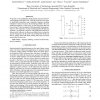Free Online Productivity Tools
i2Speak
i2Symbol
i2OCR
iTex2Img
iWeb2Print
iWeb2Shot
i2Type
iPdf2Split
iPdf2Merge
i2Bopomofo
i2Arabic
i2Style
i2Image
i2PDF
iLatex2Rtf
Sci2ools
ICASSP
2011
IEEE
2011
IEEE
Extensions of recurrent neural network language model
We present several modifications of the original recurrent neural network language model (RNN LM). While this model has been shown to significantly outperform many competitive language modeling techniques in terms of accuracy, the remaining problem is the computational complexity. In this work, we show approaches that lead to more than 15 times speedup for both training and testing phases. Next, we show importance of using a backpropagation through time algorithm. An empirical comparison with feedforward networks is also provided. In the end, we discuss possibilities how to reduce the amount of parameters in the model. The resulting RNN model can thus be smaller, faster both during training and testing, and more accurate than the basic one.
Related Content
| Added | 21 Aug 2011 |
| Updated | 21 Aug 2011 |
| Type | Journal |
| Year | 2011 |
| Where | ICASSP |
| Authors | Tomas Mikolov, Stefan Kombrink, Lukas Burget, Jan Cernocký, Sanjeev Khudanpur |
Comments (0)

